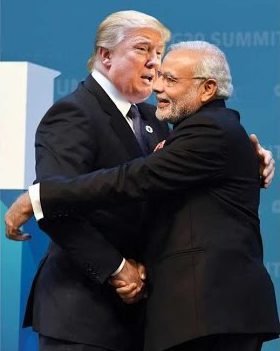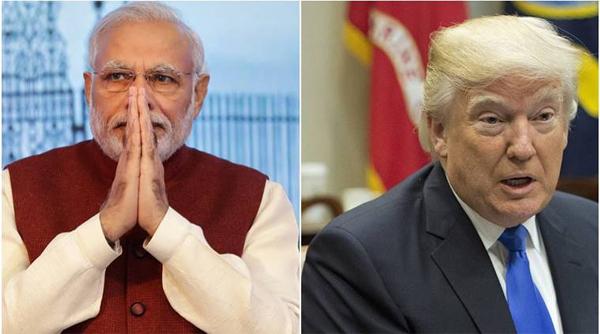Narendra Modi and Donald Trump are often compared to each other for their common traits and both have time and against stated their mutual administration for each other’s achievements. But despite all his penchant for the ‘riffraff’ President Trump has done a lot more to further his ‘America First’ policy in a relatively shorter period, irrespective of what the world would like to think about him, compared to what Modi has managed to do with his promises over a much longer time frame. Here’s a report, for Different Truths.
Governments all over the world are evaluating the success or failure of their policies in terms of the number of jobs created or lost. Donald Trump’s presidential campaign was predicated on the promise to protect American jobs, particularly in the steel industry, for the collapse of which he squarely blamed the wrong policies of the previous administrations and other nations. He has since followed up his promise with concrete actions, the latest in the series being slapping of 25 percent tariff on steel along with 10 percent on aluminum. The action has set off nearly a trade war, with the European Union leaders threatening retaliatory strike as thousands of European steel jobs have been threatened by the US trade barrier. More than the loss of export revenue, what is agitating Europe is the job loss. It is only in India that job creation is an item of low priority for the government.
Narendra Modi and Donald Trump are often compared to each other for their common traits and both have time and against stated their mutual administration for each other’s achievements. But despite all his penchant for the ‘riffraff’ President Trump has done a lot more to further his ‘America First’ policy in a relatively shorter period, irrespective of what the world would like to think about him, compared to what Modi has managed to do with his promises over a much longer time frame. During the run-up to the 2014 elections, Modi had blamed the UPA government for the acute unemployment problem in the country and had promised to create one crore new jobs every year if his party was voted to power.
But his performance on this front so has been dismal. In 2016-17, only 4.1 lakh jobs were created as against the promise of one crore. In fact, now into the fourth year, according to the Modi government’s own data, the unemployment rate has registered an increase since the BJP government began its term in 2014. According to the statistics, the unemployment rate in 2015-16 was 5 percent of the labour force, up from 4.9 percent in 2013-14, the year before the BJP assumed power. Also, there has been a shift in the pattern of employment from permanent jobs to casual and contract jobs. The temporary nature of work obviously had an adverse effect on the level of wages, the stability of employment, and social security.
Instead of owning up the lapse, the government came up with outlandish explanations to cover up the  failure. The storm over Modi’s highly inappropriate description of someone selling pakoda as a gainfully employed person, parroted by party chief Amit Shah, brought further embarrassment to the government. Both Modi and Shah were pilloried for the remark, which appeared to be quite uncharacteristic of the Prime Minister, who is otherwise known for his complete mastery over the language and metaphors he uses. But for the discerning, there was a certain method in the madness. The Modi government knows that it is a losing proposition to try and create jobs for the 60-70 lakh workforce that gets added every year to the job market. At the same time, 80 percent of the workers are engaged in the informal sector. So the only option to dress up the numbers to show some respectability is to bring the ‘pakoda-wallahs’ and other cash earners into the formal economy.
failure. The storm over Modi’s highly inappropriate description of someone selling pakoda as a gainfully employed person, parroted by party chief Amit Shah, brought further embarrassment to the government. Both Modi and Shah were pilloried for the remark, which appeared to be quite uncharacteristic of the Prime Minister, who is otherwise known for his complete mastery over the language and metaphors he uses. But for the discerning, there was a certain method in the madness. The Modi government knows that it is a losing proposition to try and create jobs for the 60-70 lakh workforce that gets added every year to the job market. At the same time, 80 percent of the workers are engaged in the informal sector. So the only option to dress up the numbers to show some respectability is to bring the ‘pakoda-wallahs’ and other cash earners into the formal economy.
The case with Modi’s other promises wasn’t any different. He promised to bring all black money stashed away by Indians in foreign banks, and distribute it among the common people, who voted his party with an overwhelming majority. But the whole idea turned out to be a pipedream, which it continues to be even today, and the government conveniently kept mum as if nothing happened. Many of Modi’s schemes, announced with great fanfare, met with similar fate. Schemes there were a dime a dozen, but with each new announcement, the previous one was relegated to the background. There was an apparent lack of focus.
But whenever his schemes produced results, it had negative results, like it happened with demonetisation. The one step that Modi hoped would set everything right went terribly wrong and pushed the economy and life itself a few notches back. The impact of the ‘monumental blunder’ is still being felt as the informal sector got an unprecedented battering, which will take ages to recover from, casting a long shadow on the country’s growth prospects. There was further messing up, when GST, another major decision, was rolled out in a half-baked condition, the adverse effects of which are still continuing.
Obviously, the Modi government has failed to do proper book-keeping of its performance. That is why leaders like Yogi expressed shock when he lost two prestigious by-elections in his state, which gave the party a jolt. But the results of recent elections show that people have been keeping score of what the government has done and failed to do. They seem to have seen through the Modi magic and realised it is a mere gimmick.
K Raveendran
©IPA Service
Photos from the Internet
#ModiGovernment #IndianPolitics #DonaldTrump #ComparingLeaders #India #Elections #DifferentTruths





 By
By
 By
By

 By
By